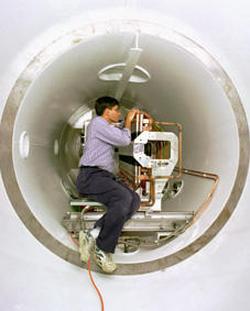A Universal Asymmetry

There’s a lot more matter than antimatter in the Universe, but particle physicists still do not fully understand why. They think the asymmetry is caused at least in part by another asymmetry known as CP violation, a slight lopsidedness in the basic laws of physics. In February the KTeV collaboration at the Fermi National Accelerator Laboratory (Fermilab) in Illinois announced the most accurate measurement ever of one aspect of this effect, and their value was larger than previous measurements and theoretical predictions. They report their results in the 5 July PRL. Although theorists say the measurement is probably consistent with the standard model of particle physics, given uncertainties, it seems to completely rule out some more exotic theories.
The laws of physics look almost the same, but not quite identical, when fundamental interactions are viewed in a mirror with all particles replaced by antiparticles. This puzzling fact, known as CP violation, was revealed in 1964 experiments on K mesons, the only particles where the effect has been observed conclusively. The Nobel Prize winning work demonstrated that the long-lived K-long particle occasionally decays into two pions, rather than three, an impossible occurrence in a perfect CP-symmetric world. Theorists explained the observation by proposing that the K-long contains a mostly CP-respecting kaon called K2 mixed with a bit of CP-violating “impurity,” called K1. The fraction of this impurity, called epsilon, first measured in 1964, is about 0.002.
But the standard model also implied that the K2 itself can very rarely decay into the CP-violating two pions. This “direct” CP violation, characterized by epsilon-prime, was expected to be much smaller than the “indirect” variety, and particle physicists have been trying to measure it since the mid-1980s. In 1993 teams at the European Laboratory for Particle Physics (CERN) in Switzerland and Fermilab reported values for the ratio of epsilon-prime to epsilon that did not agree: CERN’s team said it was 23 × , while Fermilab’s team got one third that, with a large relative uncertainty. “It left the situation kind of unclear,” says KTeV member Peter Shawhan. “There was evidence [for direct CP violation], but it wasn’t confirmed.”
During 1996 and 1997 the KTeV team measured millions of decays of K mesons created by the Fermilab 800 GeV proton beam striking their BeO target. Their final value for epsilon-prime/epsilon (announced in February) is (28 ± 4) × , which is consistent with CERN’s value of (18.5 ± 7) × (announced in June) and seems to establish direct CP violation as a true effect. The new Fermilab value surprised many in the field because it’s closer to CERN’s 1993 result than it is to the previous Fermilab measurement and because recent theoretical predictions were somewhat lower. But there is still room for agreement with the standard model, given all of the uncertainties, according to Lincoln Wolfenstein of Carnegie-Mellon University in Pittsburgh.
35 years ago Wolfenstein proposed an explanation of CP violation known as the “superweak” mechanism, which goes beyond the standard model, but it is ruled out by the new results because it predicts very little direct CP violation, if any. Yet Wolfenstein is pleased with the KTeV results because he and others have been looking forward to such a measurement for decades. “This is the first independent CP violation experiment” since 1964, he says. Regarding the slight asymmetry in the laws of physics caused by CP violation, Wolfenstein remarks that “The world is the way it is and not the way we imagine.”


